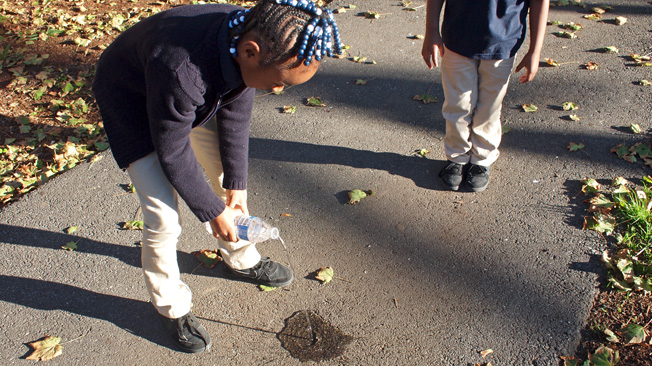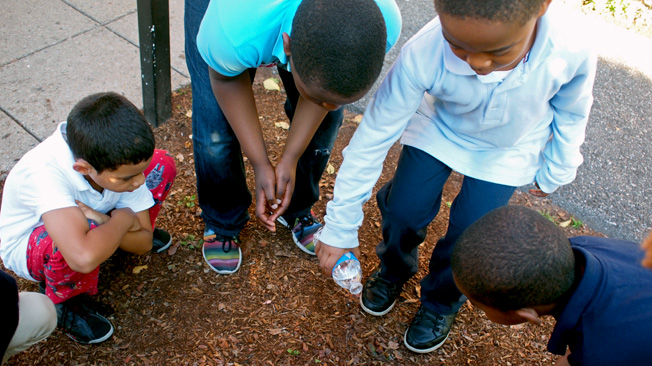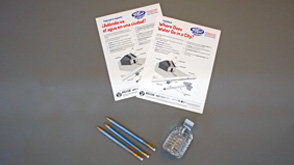H2O on the Go
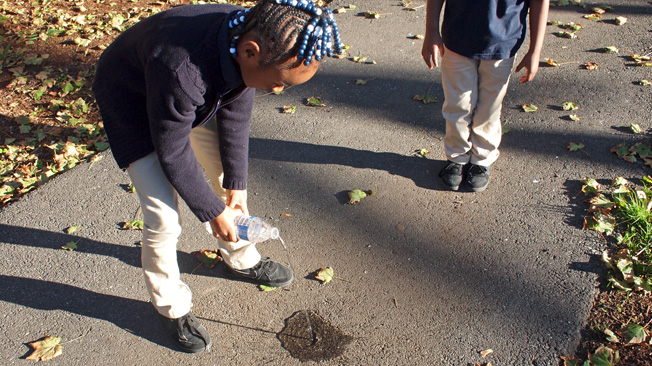
What Is This Activity?
Where does water flow—and not flow—in a city? Kids model surfaces that absorb water and those that don't, and investigate structures that control water flow in cities and towns.
Introduction
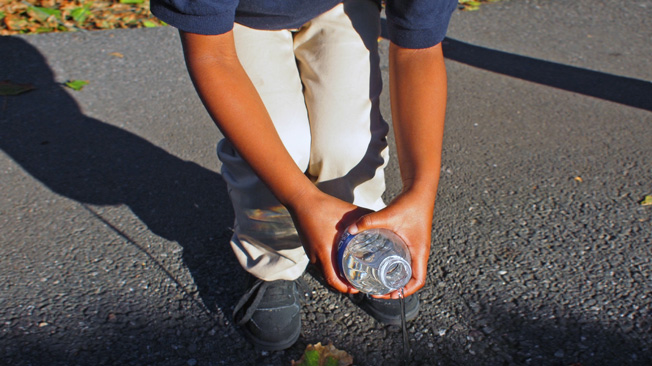
Learning Goals
Big Science Idea:
- When rain falls and snow melts, some surfaces let water soak into the ground, and some don't.
Skills kids will use to investigate the idea:
- Model, observe, and compare how water flows over non-porous surfaces (pavement) and absorbs into porous ones (grass, soil, some fabrics)
- Observe and discuss how a drainage system moves flowing water out of a city or town and how this water loss affects plant and animal survival
- Communicate and summarize new ideas and information about the importance of controlling the flow of water in a city or town, and its effects on animals and plants
How Do You Get Ready?
- Read the activity and gather the materials.
- Print out one copy per kid of the "Where Does Water Go in a City?" handout.
- Scout out a walking route that allows kids to see rain gutters, downspouts, street gutters, storm drains, and (for the hands-on activity) a green space such as your program's yard, a park, or a playground. A green space with a running water source, such as a drinking fountain or hose, is ideal since you can bring empty cups or bottles and fill them on site. If water is not available on site, have kids carry their own full water bottles to the green space.
- Troubleshoot safety concerns (traffic, poison ivy, sharp objects, etc.).
- If you don't plan to show the "Hidden Alligator Mystery" video that is paired with this activity on the website, watch it ahead of time and note key concepts to share with kids during the activity
Warm-up 8-10 minutes
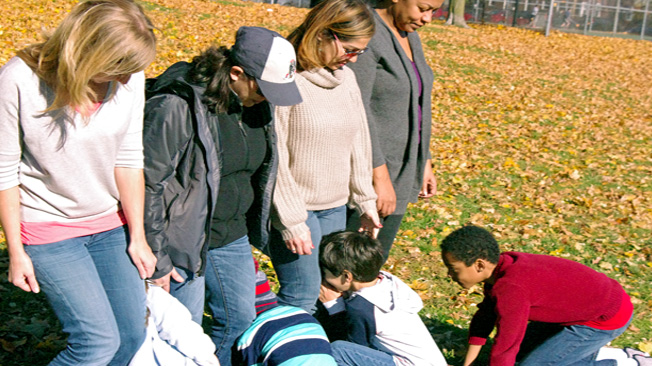
(Science Skills: Model how paved surfaces block rainwater and soil lets water pass through)
Ready, Set, Go with the Flow! This Red Rover-type game models how water behaves on asphalt or concrete versus grass, sand, and soil.
- In an open space outdoors, divide the group into two teams, the "Raindrops" and the "Ground."
- Position the teams about 20 yards apart.
- The Ground kids stand in a line, shoulder to shoulder. Explain that they are like a paved surface (e.g., asphalt) with no openings.
- On your signal, the Raindrops "fall" by running toward the Ground team. Each Raindrop tries to pass through "the asphalt" without touching it. Impossible! They have to stop ("puddle") or divert ("stream" right or left around either end of the line).
- Repeat the game, but this time the Ground kids model grass. They open holes by placing their right arm on the shoulder of the person next to them. The Raindrops can now slip through those spaces.
- Discuss: How does this game remind you of raindrops falling to the ground? (On hard, non-porous surfaces such as streets, sidewalks, and parking lots, rain can't pass through, so it either forms a puddle or streams away. On porous surfaces such as grass or dirt, rain is absorbed through small holes in the ground.)
Activity 30-40 minutes
Creating Creatures
(10-15 minutes)
(Science Skills: Observe and compare how water flows over non-porous surfaces and absorbs into porous surfaces)
- Gather on a paved surface (e.g., basketball court, sidewalk) and make sure everyone has a full water bottle.
- Have each person pick a spot and pour half their water onto the surface, paying close attention to where and how the water moves.
- Repeat the activity over grass or dirt.
- Ask kids to describe and compare results. (Hand out paper and pencils and have them write them down if desired.) Ask: Any surprises? (On paved surfaces, water generally stays on the surface unless there's a crack; it spreads in all directions on a level surface but flows downhill on a tilted surface. On grass or dirt, water sinks in, or is absorbed into the ground. If it moves at all, it flows slowly before sinking in.)
- Ask: Why does grass absorb water but asphalt doesn't? (Grassy surfaces have tiny holes in the ground that let water in. Asphalt is solid.)
- Have kids look at what they're wearing and think about which fabrics let water through or keep water out. How could they prove it? The easy answer: Try it!
- Ask older or more mature kids to describe how they could create a science experiment to determine which fabrics let water through and which don't (e.g., stretching various fabrics over clear cups, pouring half a cup of water onto each swatch, and measuring the water that drips through into the cups).
- Ask: Does skin let water through? (Yes! Sweat flows out of your skin.)
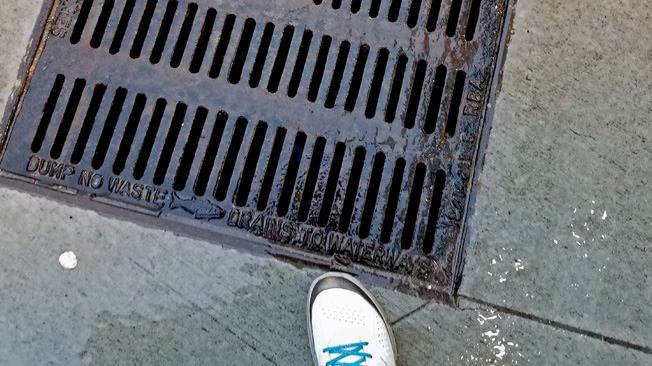
Find the Water
(20-25 minutes)
(Science Skills: Observe and discuss how a drainage system moves flowing water out of a city or town and how this water loss affects plant and animal survival)
- Give kids the "Where Does City Water Go?" handout and review the path of water from rooftops to beyond city limits.
- Lead the group on a 15-minute scavenger hunt around the neighborhood to find and check off the parts of a drainage system. Can anyone find parts that are not on the list? Optional: Have kids take photos of the parts of the system they find to discuss later.
- Discuss briefly: Why is it important to think about water flow in a city? (Lots of water collects on paved surfaces when it rains or snows because it can't soak into the ground. This water on paved surfaces could cause a flood unless people build structures to take it out of the area. Grass and soil absorb water, keeping it in city or town and available for animals and plants to use. Plants "drink" the water; animals eat the plants.)
- Ask: What are some types of surfaces in cities and towns that don't absorb water? (Streets, sidewalks, stoops, parking lots, roofs, and buildings, etc.) How much of your neighborhood is paved versus not paved? (Kids will have general answers like "lots." Encourage them to explain their responses.)
- Remind them that a storm drainage system carries rainwater and melted snow out of a city or town. (Note: Sewer systems are different; they carry wastewater from kitchens and bathrooms to a water-treatment plant.) What if there were no storm drains? Or the drains become full or blocked? (Water would pool or flood streets and sidewalks.)
Wrap-up 5-10 minutes
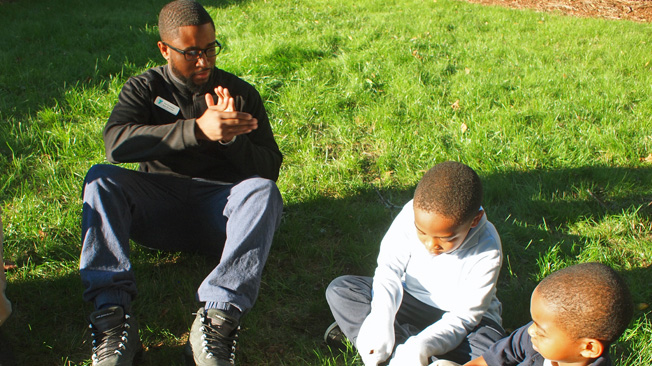
(Science Skills: Communicate and summarize new ideas and information about the importance of controlling the flow of water in a city or town, and its effects on animals and plants)
- Ask kids to share their favorite part of the activity.
- Ask: How many parts of the drainage system did you find? If they took pictures, have them share and briefly discuss their pictures. What part of the system is it? What does it do?
- Discuss: Why is water loss through drainage a problem in a city or town? Why are parks and other green spaces important? (Many reasons, such as absorbing rainwater and providing places for plants and animals to grow and be healthy.)
- If you haven't already, send home the "Explore Water Around You" handout to provide families with ideas on how to continue investigating water together.
Explore Some More
Where Does the Snow Go?
Watch Where Does the Snow Go? – a video in which Plum sings a song about what happens to snow in the city after a storm. Ask kids why the snow can't soak through concrete, and what happens to it instead.
Where Will the Water Go?
Using Google Earth, enter a local address in the search box and then drag the "street view" icon onto the map. Note the elevation readout at the bottom of the screen. Enter other addresses and use the elevation readings to locate high and low points in your area. Ask: Which spots are most likely to flood?
Explorer's Notebook
Use the template provided: Have kids draw a simple diagram of a city's drainage system. If they took photos of the parts (optional), they can use them for reference. Guide them by having them picture a raindrop as it moves from high to low: from the sky, onto a roof, through the gutter, down the downspout, onto the street, along a street gutter, into a storm drain, out of the city or town.

